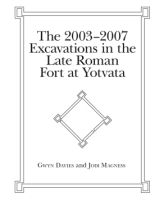
The 2003-2007 Excavations in the Late Roman Fort at Yotvata
Gwyn Davies and Jodi Magness, with Nathan T. Elkins, Rebecca Halbmaier, Jennifer Ramsay, Alexandra Ratzlaff, Carolyn Swan, Zlatko Plese, Darden Hood, and Elisabetta Boaretto
The 2003-2007 Excavations in the Late Roman Fort at Yotvata
Gwyn Davies and Jodi Magness, with Nathan T. Elkins, Rebecca Halbmaier, Jennifer Ramsay, Alexandra Ratzlaff, Carolyn Swan, Zlatko Plese, Darden Hood, and Elisabetta Boaretto
“The richly illustrated volume presents the archaeology and finds from the fort, as well as analyses of floral and faunal remains. Among the most exciting finds—attesting to the Roman emperor Diocletian’s reorganization of Arabia and Palaestina—is a monumental Latin inscription . . . indicating that the fort was established in the late third century C.E. by Aufidius Priscus, governor of the province of Palaestina, who is also known from an inscription on a marble column found in Caesarea Maritima.”
- Description
- Reviews
- Table of Contents
The Late Roman fort at Yotvata is located in the southern Arava some 40 km north of Eilat/Aqaba (ancient Aila). The modern Hebrew name of the site is based on its suggested identification with biblical Jotbathah (Deut 10:7), where the Israelites encamped during their desert wanderings. The modern Arabic name of the site, Ein Ghadian, may preserve the ancient Roman name Ad Dianam. Because the Late Roman fort at Yotvata is visible as a low mound next to the Arava road, it has long been known to scholars. Each June between 2003 and 2007, Gwyn Davies (Florida International University) and Jodi Magness (University of North Carolina at Chapel Hill) co-directed excavations here. This volume provides the results of those excavations, adding substantially to our knowledge of Roman defenses in the third and fourth centuries of the Common Era, along the trade route that traversed the southern Arava and on the eastern frontier of the Empire.
“The richly illustrated volume presents the archaeology and finds from the fort, as well as analyses of floral and faunal remains. Among the most exciting finds—attesting to the Roman emperor Diocletian’s reorganization of Arabia and Palaestina—is a monumental Latin inscription . . . indicating that the fort was established in the late third century C.E. by Aufidius Priscus, governor of the province of Palaestina, who is also known from an inscription on a marble column found in Caesarea Maritima.”
Preface
Chapter 1. The 2003–2007 Excavations: Architecture and Stratigraphy
Chapter 2. The Pottery
Chapter 3. The Glass
Chapter 4. The Coins
Chapter 5. The Militaria and Small Finds
Chapter 6. The Faunal Remains
Chapter 7. The Archaeobotanical Remains
Appendix 1. Complete Locus List
Appendix 2. Wall List
Appendix 3. Critical Loci List
Mailing List
Subscribe to our mailing list and be notified about new titles, journals and catalogs.



